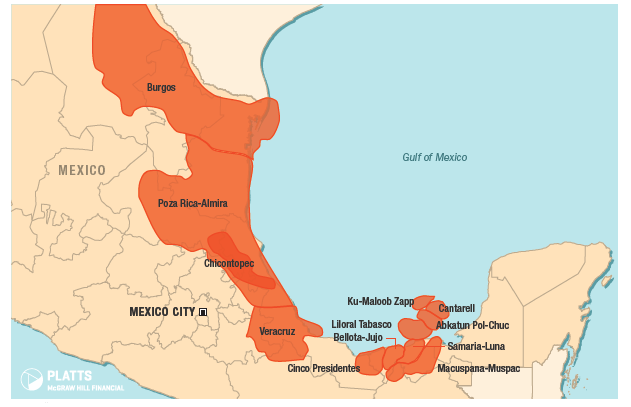Opportunity strikes for International Frontier Resources: Canadian E&P wins bid at auction in Mexico
After 77 years, the Mexican government held its auction for oil and gas rights in July of last year. The first auction since Mexico’s decision to loosen the grip of the state-run monopoly held by national oil giant PEMEX saw just two of fourteen shallow-water blocks sold, but the tides soon turned. Mexico’s subsequent deep-water auction garnered much more attention, and the third auction – the only onshore auction last year – saw bids for 25 blocks. Among the winners of the final auction was International Frontier Resources (ticker: IFR).
Tonalli Energia – a Mexico-based 50/50 joint venture between International Frontier Resources and Mexican petrochemical company Grupo Idesa – was awarded the Onshore Oil and Gas Onshore Development Block 24 (Tecolutla Block) by the Mexico Comision Nacional de Hidrocarburos (CNH) May 12. IFR received the block after the first place bidder was unable to meet the conditions and terms as required by CNH to close the bid, according to a press release.
Steve Hanson IFR’s President and Director of Tonalli Energia, said, “Tecolutla provides Tonalli with a strategic operating presence in the Tampico-Misantla Basin and a solid foothold into Mexico’s Energy Reform.”
The Hydrocarbons
The Tecolutla Block is 7.2 square kilometers in the Tampico-Misantle Basin located within the state of Veracruz. The oil reservoir in the block is the El Abra formation at a depth of 2,340 meters (about 7,700 feet). 3D seismic has been acquired over the entire Tecolutla Block and 7 wells have been drilled into the producing reservoir. Peak production of over 900 barrels per day was recorded in 1972 from 3 wells, with 1 producing well remaining as of December 2014.
 The auctions taking place in Mexico are unique in that the country is selling off producing assets with known reserves, as opposed to exploratory blocks. While the first auction attracted lackluster bids, the subsequent tweaking done by the government appears to be attracting bidders.
The auctions taking place in Mexico are unique in that the country is selling off producing assets with known reserves, as opposed to exploratory blocks. While the first auction attracted lackluster bids, the subsequent tweaking done by the government appears to be attracting bidders.
The government’s financial terms for the auction consisted of a special royalty of 1%-10%, depending on the quality of the fields, in addition to the standard oil and gas royalty, plus income tax and other fees. That put the base “government take,” or the percentage of the oil profits the government keeps, at roughly 50%. Companies were able to increase the special royalty rate as part of their bid, but International Frontier Resources was able to secure a lower than average rate on the Tecolutla Block.
The incremental royalty that will be applicable to the license agreement to be entered into by Tonalli will be 31.22%, less than half of the 68.40% offered by the first place bidder. The average incremental royalty for the 25 blocks sold in the onshore auction is 47.22%, according to IFR. The term of the license agreement will be 35 years.
The company announced a private placement of 12.8 million units earlier this month, with the potential to bring in gross proceeds of $1.6 million, which the company said will be used for working capital and to fund its Mexico initiatives. Idesa has also agreed to help jointly fund Tonalli for the technical evaluation of future onshore bidding rounds, which IFR believes could include “a significant number of under exploited oil and gas fields in Mexcio.”
Unlocking Mexico’s potential
Mexico’s oil and gas industry has been struggling under the pressure of low oil prices and an inefficient state monopoly, but the country holds substantial natural resources. The country’s oil production has steadily decreased since 2005 as a result of natural production declines from large fields, which the government hopes to combat by allowing other companies access to its hydrocarbons after 75 years, according to the EIA.
The oil sector generated 11% of the country’s export earnings in 2014, and earnings from the industry account for one-third of total government spending, making the continued health of the sector important to Mexico’s government.
In 2014, Mexico produced an average of 2.8 MMBOPD (87% crude oil), making it the fourth-largest producer of petroleum and other liquids in the Americas after the U.S., Canada, and Brazil. 2014 production was 27% below its peak in 2004. The country had 9.8 billion barrels of proved oil reserves as of the end of 2014, most of which is heavy crude located in offshore fields.
Onshore fields accounted for 25% of Mexico’s total crude oil production in 2014. Most of this production consisted of light or extra-light crude oil from the southern part of the country, accounting for 76% of Mexico’s onshore production, according to the EIA.
State-owned PEMEX has been largely unsuccessful in developing onshore assets like Chicontepec, which the company has invested in heavily. Proved reserves in the project total 637 million barrels, but the resources are held in a formation with dozens of small fields spread over hundreds of square miles, rather than in a single field, meaning they are highly fractured and at low pressure, making them more costly to recover.
As Mexico continues its energy industry reform, it is hoped that companies like International Frontier Resources will be able to find new ways to innovate and unlock the potential of Mexico’s resources in place.
International Frontier Resources will be presenting at EnerCom’s The Oil & Gas Conference® 21 in Denver on Monday, August 15, 2016. To learn more about the conference, click here.


